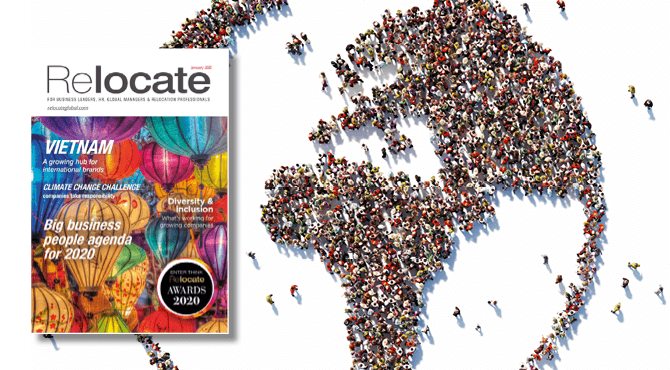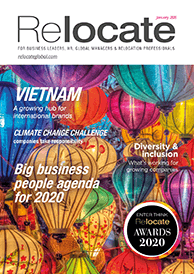A global view of immigration: making sense of today’s tensions
Immigration expert Fragomen’s research-based session at the Worldwide ERC® Boston Global Workforce Symposium in October 2019 provided clarity for these contradictory times, says Ruth Holmes.

Click on the cover to access the digital edition and order your printed copy.
Drawing on the consultancy’s in-country knowledge and global overview, Scott Leeb, Fragomen’s head of knowledge, identified three key themes – and tensions – informing immigration policies the world over.The first is the nationalist sentiment and the more restrictive immigration legislation being seen globally. This is having an impact not only on election campaigns and results, but also on the day-to-day political landscape.The second is “a recognition of the interconnected world we live in,” said Mr Leeb. “We see that fundamental tension between the push towards restrictive policies, yet the recognition we live in a connected world and the need to understand that the right people need to come to sustain and grow the national economy.”
A technological transformation
Running alongside geopolitical trends is the influence of technological transformation on the immigration environment. Fragomen’s Worldwide Immigration Trends Report 2019 talks about how immigration organisations are going down the e-route – whether it’s e-processing, e-filing or pushing a technological solution.However, this is not without its challenges. “I would say that while you have the political rhetoric pushing for technology, in many cases, the infrastructure is not mature enough to support this,” suggested Mr Leeb. “There is, in fact, a process inefficiency that will manifest itself over the next couple of years.”The third key theme is how the authorities are monitoring and enforcing immigration policies on the ground. Mr Leeb explained, “What we are seeing is an increase in both the number and complexity of compliance rules. We are also seeing the cost of compliance becoming greater. Not just the cost of non-compliance, but also the burden on the organisation and the people, paperwork and resources required.”Key trends in global immigration
Fragomen’s report assesses immigration trends and developments in the world’s major regions in the domains of:- Access to foreign talent
- Process change
- Government enforcement routes and compliance.
Sub-Saharan Africa
The key trends described by Mr Leeb earlier in the presentation rang true in the analysis for Sub-Saharan Africa. Immigration policies are tightening as governments are trying to protect domestic workers already in the country and increase access to the labour market; for example, with training plans and skills transfer from foreign workers to local workers.For process changes, in Nigeria, Zambia and Mozambique, new systems were implemented and there were delays, which caused missed start dates. However, the governments are not slowing down their shift to online programmes.For government enforcement and employer compliance, “the oil and gas sector continued to be targeted in 2019”. Kenya developed a new foreign worker identification system “that showed the country’s intent to want to better track foreign workers.”Latin America
The region had a busy year with increased foreign investment, particularly in the tech industry, turning cities like Medellin into tech hubs. The region was also experiencing turmoil with the Venezuelan humanitarian crisis.A lot of countries opened their doors to people from Venezuela by relaxing their visa requirements and requesting fewer documents. As the year went on, as the influx was so great and so fast, a lot of countries started asking for international help. This went into the process changes with online system developments growing in this region for every point of the immigration process. As in Africa, it came with delays, system closures and it didn’t go so smoothly. From a compliance perspective, there are months of ongoing delays in Mexico following the recent elections and government restructuring.Canada and The United States
Canada had a pretty unrestrictive year in terms of welcoming immigrants, “especially with what’s going on welcoming immigrants in the US today” said Ms Cole. “Canada’s federal policies promoted the country as the place to place workers instead of the US.” However, Quebec announced it would seek to reduce immigration levels by 20%. It is trying to promote French speakers and the exams are getting harder to pass.“As far as enforcements, the biggest issue is that the legalisation of cannabis caused issues at the border,” noted Ms Cole. There is also a continued stream of inspections by the immigration authorities, especially in the restaurant and farming industries.The US had a tumultuous year. There was increased scrutiny on employment visa applications and more agencies working together to enforce growingly stricter immigration rules.Asia
As far as access to talent, lots of countries like Japan lowered barriers to entry. Yet Singapore decreased the quota. Fragomen predicts that higher-skilled employers are likely to remain in demand, with more categories for these workers being devised. Overall, a reduced enforcing effort – except for China – was noted in the region.Europe
As far as access to talent, quotas have been relaxed in some European countries to encourage skilled workers. But others like Italy and Hungary are trying to close their doors.Middle East
This region has seen a big jump in access to talent. Lots of the region’s countries now have more liberal policies, which show they want to become a place of innovation. There is also continued interest in bringing in foreign investment and more online systems are streamlining the process. As for enforcement, states of emergency, for example in Egypt, have resulted in increased scrutiny of immigrants.Read more articles in the Winter Issue of Relocate Magazine.
Subscribe to Relocate Extra, our monthly newsletter, to get all the latest international assignments and global mobility news.Relocate’s new Global Mobility Toolkit provides free information, practical advice and support for HR, global mobility managers and global teams operating overseas. Access hundreds of global services and suppliers in our Online Directory
Access hundreds of global services and suppliers in our Online Directory
©2025 Re:locate magazine, published by Profile Locations, Spray Hill, Hastings Road, Lamberhurst, Kent TN3 8JB. All rights reserved. This publication (or any part thereof) may not be reproduced in any form without the prior written permission of Profile Locations. Profile Locations accepts no liability for the accuracy of the contents or any opinions expressed herein.


































